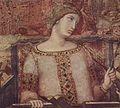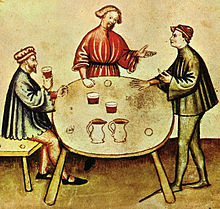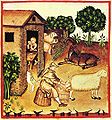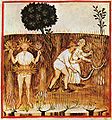Traveling within the World
Linking your favorite traveling artists across the globe
Underwear
The innermost layer of a woman's clothing was a linen or woolen chemise or smock, some fitting the figure and some loosely garmented, although there is some mention of a "breast girdle" or "breast band" which may have been the precursor of a modern bra.[26]
Women also wore hose or stockings, although women's hose generally only reached to the knee. [18]
All classes and both sexes are usually shown sleeping naked-- special nightwear only became common in the 16th century [27] -- yet some married women wore their chemises to bed as a form of modesty and piety. Many in the lower classes wore their undergarments to bed because of the cold weather at nighttime and since their beds usually consisted of a straw mattress and a few sheets.
[edit] Gowns and outerwear
Over the chemise, women wore a loose or fitted gown called a cotte or kirtle, usually ankle or floor-length, and with trains for formal occasions. Fitted kirtles had full skirts made by adding triangular gores to widen the hem without adding bulk at the waist. Kirtles also had long, fitted sleeves that sometimes reached down to over the knuckles.
Various sorts of overgowns were worn over the kirtle, and are called by different names by costume historians. When fitted, this garment is often called a cotehardie (although this usage of the word has been heavily criticized[28]) and might have hanging sleeves. Over time the hanging part of the sleeve became longer and narrower until it was the merest streamer, called a tippet, then gaining the floral or leaflike daggings in the end of the century.[29]
Sleeveless overgowns or tabards derive from the cyclas, an unfitted rectangle of cloth with an opening for the head that was worn in the 13th century. By the early 14th century, the sides began to be sewn together, creating a sleeveless overgown or surcoat.[29]
Outdoors, women wore cloaks or mantles, often lined in fur. The Houppelande was also adopted by women late in the century. Women invariably wore their Houppelandes floor-length, the waistline raising up to right underneath the bust, sleeves very wide and hanging, like angel sleeves.
[edit] Headdresses
[edit] Northern and western Europe
Married women in Northern and Western Europe wore some type of headcovering. The barbet was a band of linen that passed under the chin and was pinned on top of the head; it descended from the earlier wimple (in French, barbe), which was now worn only by older women, widows, and nuns. The barbet was worn with a linen fillet or headband, or with a linen cap called a coif, with or without a couvrechef (kerchief) or veil overall. [30] It passed out of fashion by mid-century. Unmarried girls simply just braided the hair to keep the dirt out.

The barbet and fillet or barbet and veil could also be worn over the crespine, a thick hairnet or snood. Over time, the crespine evolved into a mesh of jeweler's work that confined the hair on the sides of the head, and even later, at the back. This metal crespine was also called a caul, and remained stylish long after the barbet had fallen out of fashion.[31]
[edit] Italy
Uncovered hair was acceptable for women in the Italian states. Many women twisted their long hair with cords or ribbons and wrapped the twists around their heads, often without any cap or veil. Hair was also worn braided. Older women and widows wore a veil and wimple, and a simple knotted kerchief was worn while working. In the image at right, one woman wears a red hood draped over her twisted and bound hair.
[edit] Style gallery
- Italian gowns are high-waisted. Women's hair was often worn uncovered or minimally uncovered in Italy. Detail of a fresco by Giotto, 1304–06, Padua.
- Woman presenting a chaplet wears a linen barbet and fillet headdress. She also wears a fur-lined mantle or cloak, c. 1305–1340.
- Women at dinner wear their hair confined in braids or cauls over each ear, and wear sheer veils. The woman on the left wears a sideless surcoat over her kirtle, and the woman on the right wears an overgown with fur-lined hanging sleeves or tippets. Luttrell Psalter, England, c. 1325–35.
- Woman in a garden on a breezy day. Her kirtle sleeves button from the elbow to the wrist, and she wears a sheer veil confined by a fillet or circlet. Her skirt has a long train. Luttrell Psalter, c. 1325–35.
- Illustration from the French Romance of Alexander, 1338–44, shows a woman wearing a red hood on her head and an overgown with vair-lined hanging sleeves or tippets
- Italian fashion of this period features broad bands of embroidered or woven trim on the gown and around the sleeves.[32] Siena, c. 1340
- A bride wears a long fur-lined gown with hanging sleeves over a tight-sleeved kirtle, with a veil. Her gown is trimmed with embroidery or (more likely) braid. A royal lady wears a blue mantle hanging from her shoulders; her hair is worn in two braids beneath her crown, Italy, 1350s.
- An indiscreet young woman wears an early houppelande and poulaines, the long pointed shoes that would be worn through most of the next century by the most fashionable. Her hair is wrapped and twisted around her head, late 14th century.
[edit] Footwear
Footwear during the fourteenth century generally consisted of the turnshoe, which was made out of leather.[33] It was fashionable for the toe of the shoe to be a long point, which often had to be stuffed with material to keep its shape.[34] A carved wooden-soled sandal-like type of clog or overshoe called a patten would often be worn over the shoe outdoors, as the shoe by itself was generally not waterproof.[35]
[edit] Working class clothing
Images from a fourteenth century manuscript of Tacuinum Sanitatis, a treatise on healthful living, show the clothing of working people: men wear short or knee-length gowns and thick shoes, and women wear knotted kerchiefs and gowns with aprons. For hot summer work, men wear shirts and braies and women wear chemises. Women tuck their gowns up when working.
[edit] See also
[edit] Notes
- ^ Laver, James: The Concise History of Costume and Fashion, Abrams, 1979, p. 62
- ^ Fernand Braudel, Civilization and Capitalism, 15th-18th Centuries, Vol 1: The Structures of Everyday Life," p. 317, William Collins & Sons, London 1981
- ^ Singman, Jeffrey L. and Will McLean: Daily Life in Chaucer's England, page 93. Greenwood Press, London, 2005 ISBN 0-313-29375-9
- ^ See discussion in Laver: The Concise History of Costume and Fashion
- ^ "The birth of fashion", in Boucher, François: 20,000 Years of Fashion, Harry Abrams, 1966, p. 192
- ^ Fernand Braudel, Civilization and Capitalism, 15th–18th Centuries, Vol 1: The Structures of Everyday Life," pp. 312–3 and 323, William Collins & Sons, London 1981
- ^ Boucher, 20,000 Years of Fashion, pp. 192–193
- ^ a b Singman & McLean, id, p. 94
- ^ a) Donald King in Jonathan Alexander & Paul Binski (eds), Age of Chivalry, Art in Plantagenet England, 1200–1400, p 157, Royal Academy/Weidenfeld & Nicholson, London 1987 and b) An Introduction to a History of Woodcut, Arthur M. Hind,p 67, Houghton Mifflin Co. 1935 (in USA), reprinted Dover Publications, 1963 ISBN 0-486-20952-0
- ^ Donald King in Jonathan Alexander & Paul Binski (eds), op cit, p 160
- ^ id, p. 95
- ^ Koslin, Désirée, "Value-Added Stuffs and Shifts in Meaning: An Overview and Case-Study of Medieval Textile Paradigms", in Koslin and Snyder, Encountering Medieval Textiles and Dress, pp. 237–240
- ^ Black, J. Anderson, and Madge Garland: A History of Fashion, 1975, ISBN 0-6880-2893-4, p. 122
- ^ Crowfoot, Elizabeth, Frances Pruchard and Kay Staniland, Textiles and Clothing c. 1150 – c. 1450, Museum of London, 1992, ISBN 0-1129-0445-9,
- ^ Georges Duby ed.,A History of Private Life, Vol 2 Revelations of the Medieval World, 1988 (English translation), p.571, Belknap Press, Harvard U
- ^ Netherton, Robin, "The Tippet: Accessory after Fact?", in Robin Netherton and Gale R. Owen-Crocker, editors, Medieval Clothing and Textiles, Volume 1
- ^ Favier, Jean, Gold and Spices: The Rise of Commerce in the Middle Ages, 1998, p. 66
- ^ a b c d e f g Singman and McLean: Daily Life in Chaucer's England, p.101
- ^ There is a famous surviving example in the Textile Museum at Lyon, called the "Pourpoint of Charles of Blois". It is made of highly tailored silk brocade (a total of twenty pieces of the brocade) with gold threads and lined with linen canvas. It is quilted throughout, probably stuffed with cotton. Description and photos and another photo, several in colour. Archived 2009-10-19.
- ^ id. p. 97
- ^ Continuation of chronicle of Guillaume de Nangis, Archives Nationales, Paris. Quoted in: Fernand Braudel, Civilization and Capitalism, 15th-18th Centuries, Vol 1: The Structures of Everyday Life," p. 317, William Collins & Sons, London 1981
- ^ Claude Blair in: Jonathan Alexander & Paul Binski (eds), Age of Chivalry, Art in Plantagenet England, 1200–1400, Royal Academy/Weidenfeld & Nicholson, London 1987, p 480.The effigy and arming-coat of the Black Prince
- ^ Barbara Tuchman;A Distant Mirror, 1978, Alfred A Knopf Ltd, p456, quoting Vaughan's biography of Philip.
- ^ Laver, Concise History of Costume and Fashion
- ^ Claude Blair, in Alexander & Binski, op cit pp 169–70
- ^ Singman and McLean: Daily Life in Chaucer's England, page 98
- ^ History of Nightwear (German)
- ^ La Cotte Simple
- ^ a b Payne, Blanche: History of Costume from the Ancient Egyptians to the Twentieth Century, Harper & Row, 1965
- ^ Laver, James: The Concise History of Costume and Fashion, Abrams, 1979;
- ^ Payne, History of Costume
- ^ Boucher, 20,000 Years of Fashion
- ^ A Practical Guide to Reproducing 14th Century Shoes
- ^ Singman, Jeffrey L. and Will McLean: Daily Life in Chaucer's England, page 114. Greenwood Press, London, 2005 ISBN 0-313-29375-9
- ^ id. p. 116
Tags:
Replies to This Discussion
Events
-
2014 is the Chinese Year of the Horse
February 17, 2026 at 12am to February 5, 2027 at 12am – where & how you choose
Birthdays
Birthdays Tomorrow
Important (read & understand)
Skype: Travelingraggyman
Email and Instant Messenger:
TravelerinBDFSM @ aol/aim; hotmail; identi.ca; live & yahoo
OR
Travelingraggyman @ gmail and icq ***

1AWARD UPDATES & INFORMATION
10,000 votes - Platinum Award
5,000 votes - Gold Award
2,500 votes - Silver Award
1,000 votes - Bronze Award
300 votes - Pewter Award
100 votes - Copper Award
Member of the Associated Posting System {APS}
This allows members on various sites to share information between sites and by providing a by line with the original source it credits the author with the creation.
Legal Disclaimer
***************We here at Traveling within the World are not responsible for anything posted by individual members. While the actions of one member do not reflect the intentions of the entire social network or the Network Creator, we do ask that you use good judgment when posting. If something is considered to be inappropriate it will be removed
Site Meter
This site is strictly an artist operational fan publication, no copyright infringement intended
Patchwork Merchant Mercenaries had its humble beginnings as an idea of a few artisans and craftsmen who enjoy performing with live steel fighting. As well as a patchwork quilt tent canvas. Most had prior military experience hence the name.
Patchwork Merchant Mercenaries.
Vendertainers that brought many things to a show and are know for helping out where ever they can.
As well as being a place where the older hand made items could be found made by them and enjoyed by all.
We expanded over the years to become well known at what we do. Now we represent over 100 artisans and craftsman that are well known in their venues and some just starting out. Some of their works have been premiered in TV, stage and movies on a regular basis.
Specializing in Medieval, Goth , Stage Film, BDFSM and Practitioner.
Patchwork Merchant Mercenaries a Dept of, Ask For IT was started by artists and former military veterans, and sword fighters, representing over 100 artisans, one who made his living traveling from fair to festival vending medieval wares. The majority of his customers are re-enactors, SCAdians and the like, looking to build their kit with period clothing, feast gear, adornments, etc.
Likewise, it is typical for these history-lovers to peruse the tent (aka mobile store front) and, upon finding something that pleases the eye, ask "Is this period?"
A deceitful query!! This is not a yes or no question. One must have a damn good understanding of European history (at least) from the fall of Rome to the mid-1600's to properly answer. Taking into account, also, the culture in which the querent is dressed is vitally important. You see, though it may be well within medieval period, it would be strange to see a Viking wearing a Caftan...or is it?
After a festival's time of answering weighty questions such as these, I'd sleep like a log! Only a mad man could possibly remember the place and time for each piece of kitchen ware, weaponry, cloth, and chain within a span of 1,000 years!! Surely there must be an easier way, a place where he could post all this knowledge...
Traveling Within The World is meant to be such a place. A place for all of these artists to keep in touch and directly interact with their fellow geeks and re-enactment hobbyists, their clientele.
© 2024 Created by Rev. Allen M. Drago ~ Traveler.
Powered by
![]()

















